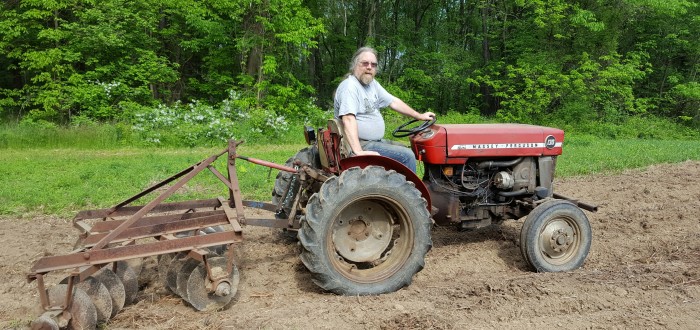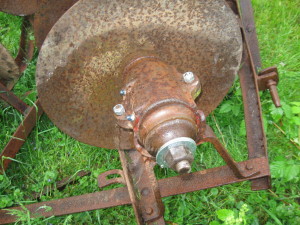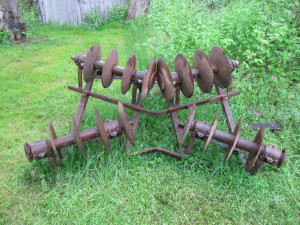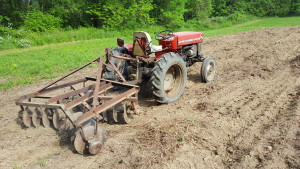As I started to tell you about last weeks, I have been working on my new (old) farm discs. I got the first axle apart and back together, so I figured that now that I knew the parts and how they fit together, I shouldn’t have too much trouble with the other three. WRONG!
I loosened the axle box bolts on the next axle without any trouble and got the axle out on the ground where I could work on it, and I immediately noticed that something was wrong. The big nut on the end of the axle shaft was all the way on on this one, and about 1/2 inch of axle was showing past the nut. I cleaned the rust off the threads and they just looked wrong. Sure enough they were left hand threads. Standard threads are what they call right hand threads. Right hand threaded nuts and bolts tighten clockwise, and unthread counterclockwise when you look at the end. Everybody knows that, even my non-mechanical wife knows the old “righty tighty – lefty loosey” saying. Well left hand threads are cut the other way, so they tighten and loosen opposite regular bolts. They are only used where motion would loosen them when a mechanism is moving. Their most common application is – you guessed it – axle nuts! Good thing that I noticed it before I started, or else I could have worked on it until the cows came home and all I would have done is make it tighter.
So I reversed the impact wrench and tried to tighten (loosen) the nut. No dice, it was rusted tighter than the last one. I tried with my propane torch and still no luck. I was wracking my brain about what to try next, when I remembered that I have a small propane/oxygen torch kit that I bought at a sale long ago and never have used. Propane/oxygen torches are similar to acetylene/oxygen torches that they use for cutting and welding steel in shops, just smaller. The magic part is the oxygen, which is in a second pressurized tank, which makes the flame from the torch much hotter – just what I needed. I rushed to get out the torch kit and once I figured out how it worked I heated the nut up until it was almost cherry red. Soon the nut was off the axle and smoking in the grass. I then cleaned up the threads the same way, and spaced the axle correctly. Just two more.
The back two axles went smoother but still held more surprises. The axle box bolts on the back axle turned out to be standard coarse thread (remember that on the front they were rare fine threads?) so someone had changed them sometime in the past. Also I had to change the grease fittings on the axle boxes as the old ones were too rusty to be of service. The first one came out alright, but as I tried to take out the second, it seemed to be getting shorter as it disappeared into the axle box. What the heck?? I took the axle bushing out of the box so I could see what was up, and I found out that the grease fittings were screwed into brass holders that extended into the bushings to direct the grease into the bushing and also keep them from turning, and sure enough – more left hand threads. I had to hold them in place with vise-grips while I replaced the grease fittings.
Now that I had these things figured out, the reassembly went fairly smoothly. Only the last axle gave me any trouble, not wanting to go back into place without binding. I had to loosen its mounts to get everything to line up right so it would turn as it should. There, all done. It wasn’t easy, but I shouldn’t have to do it again real soon. Now I could plow and disc my new pumpkin patch to my heart’s content. I just finished planting my seeds, and now I’m back, at the Old Hardware Store…




